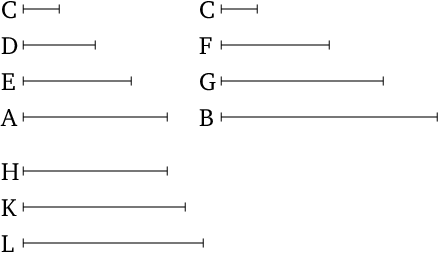Proof: By Euclid
(related to Proposition: Prop. 8.10: Product of Geometric Progressions from One)
- For let the numbers $D$, $E$ and $F$, $G$ fall between the numbers $A$ and $B$ (respectively) and the unit $C$ in continued proportion.
-
I say that, as many numbers as have fallen between each of $A$ and $B$ and the unit $C$ in continued proportion, so many will also fall in between $A$ and $B$ in continued proportion.

-
For let $D$ make $H$ (by) multiplying $F$.
- And let $D$, $F$ make $K$, $L$, respectively, by multiplying $H$.
- As since as the unit $C$ is to the number $D$, so $D$ (is) to $E$, the unit $C$ thus measures the number $D$ as many times as $D$ (measures) $E$ [Def. 7.20] .
- And the unit $C$ measures the number $D$ according to the units in $D$.
- Thus, the number $D$ also measures $E$ according to the units in $D$.
- Thus, $D$ has made $E$ (by) multiplying itself.
- Again, since as the [unit] $C$ is to the number $D$, so $E$ (is) to $A$, the unit $C$ thus measures the number $D$ as many times as $E$ (measures) $A$ [Def. 7.20] .
- And the unit $C$ measures the number $D$ according to the units in $D$.
- Thus, $E$ also measures $A$ according to the units in $D$.
- Thus, $D$ has made $A$ (by) multiplying $E$.
- And so, for the same (reasons), $F$ has made $G$ (by) multiplying itself, and has made $B$ (by) multiplying $G$.
- And since $D$ has made $E$ (by) multiplying itself, and has made $H$ (by) multiplying $F$, thus as $D$ is to $F$, so $E$ (is) to $H$ [Prop. 7.17].
- And so, for the same reasons, as $D$ (is) to $F$, so $H$ (is) to $G$ [Prop. 7.18].
- And thus as $E$ (is) to $H$, so $H$ (is) to $G$.
- Again, since $D$ has made $A$, $K$ (by) multiplying $E$, $H$, respectively, thus as $E$ is to $H$, so $A$ (is) to $K$ [Prop. 7.17].
- But, as $E$ (is) to $H$, so $D$ (is) to $F$.
- And thus as $D$ (is) to $F$, so $A$ (is) to $K$.
- Again, since $D$, $F$ have made $K$, $L$, respectively, (by) multiplying $H$, thus as $D$ is to $F$, so $K$ (is) to $L$ [Prop. 7.18].
- But, as $D$ (is) to $F$, so $A$ (is) to $K$.
- And thus as $A$ (is) to $K$, so $K$ (is) to $L$.
- Further, since $F$ has made $L$, $B$ (by) multiplying $H$, $G$, respectively, thus as $H$ is to $G$, so $L$ (is) to $B$ [Prop. 7.17].
- And as $H$ (is) to $G$, so $D$ (is) to $F$.
- And thus as $D$ (is) to $F$, so $L$ (is) to $B$.
- And it was also shown that as $D$ (is) to $F$, so $A$ (is) to $K$, and $K$ to $L$.
- And thus as $A$ (is) to $K$, so $K$ (is) to $L$, and $L$ to $B$.
- Thus, $A$, $K$, $L$, $B$ are successively in continued proportion.
- Thus, as many numbers as fall between each of $A$ and $B$ and the unit $C$ in continued proportion, so many will also fall in between $A$ and $B$ in continued proportion.
- (Which is) the very thing it was required to show.
∎
Thank you to the contributors under CC BY-SA 4.0! 

- Github:
-

- non-Github:
- @Fitzpatrick
References
Adapted from (subject to copyright, with kind permission)
- Fitzpatrick, Richard: Euclid's "Elements of Geometry"
